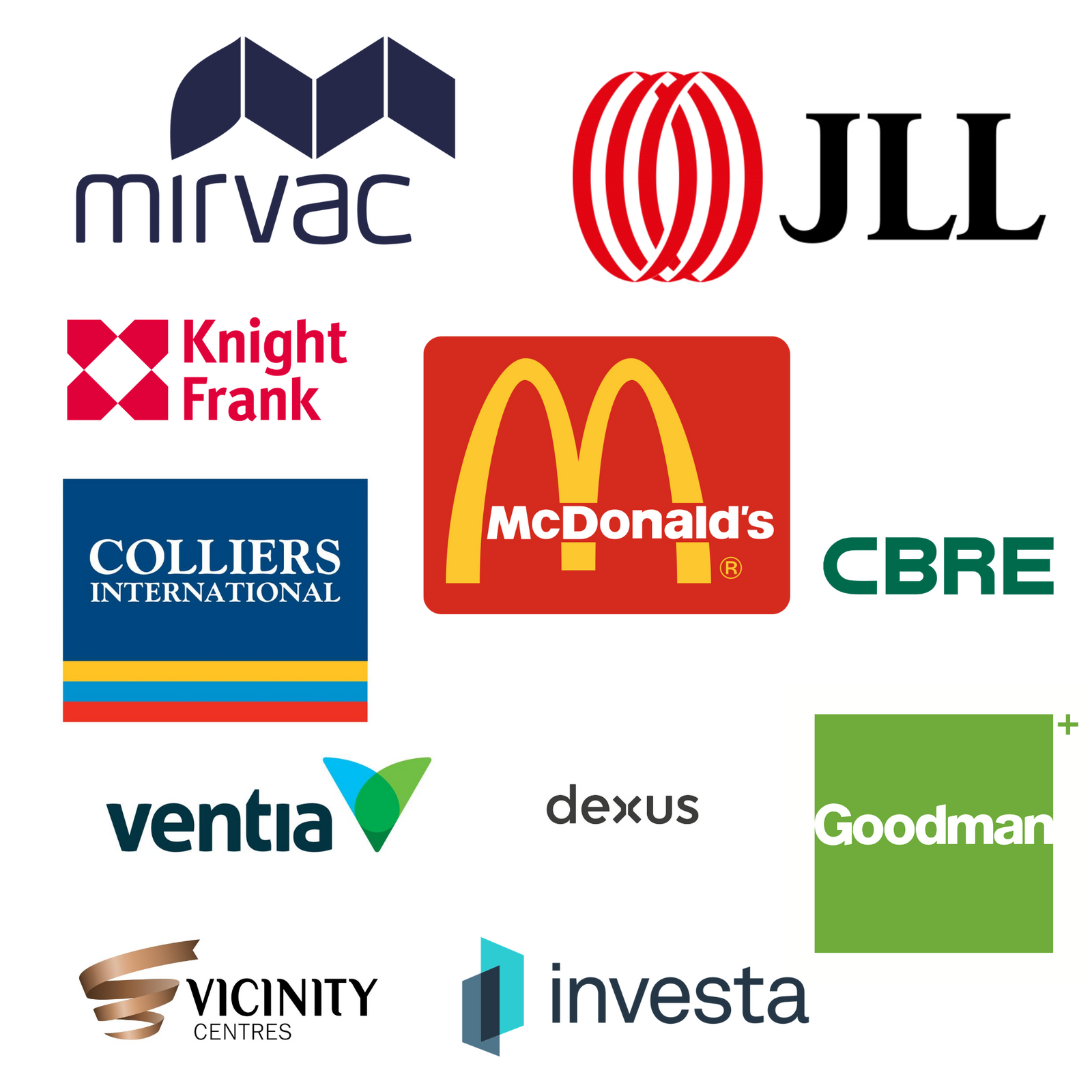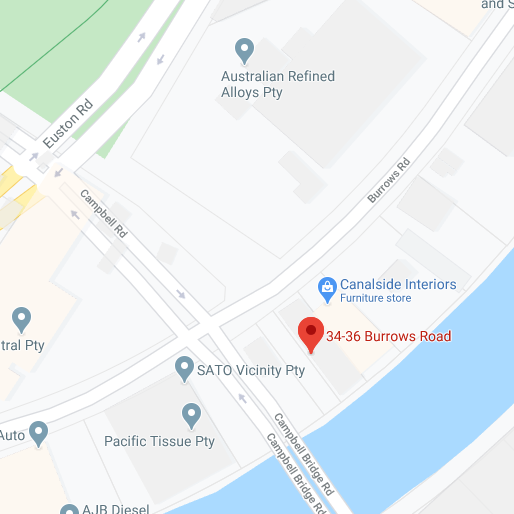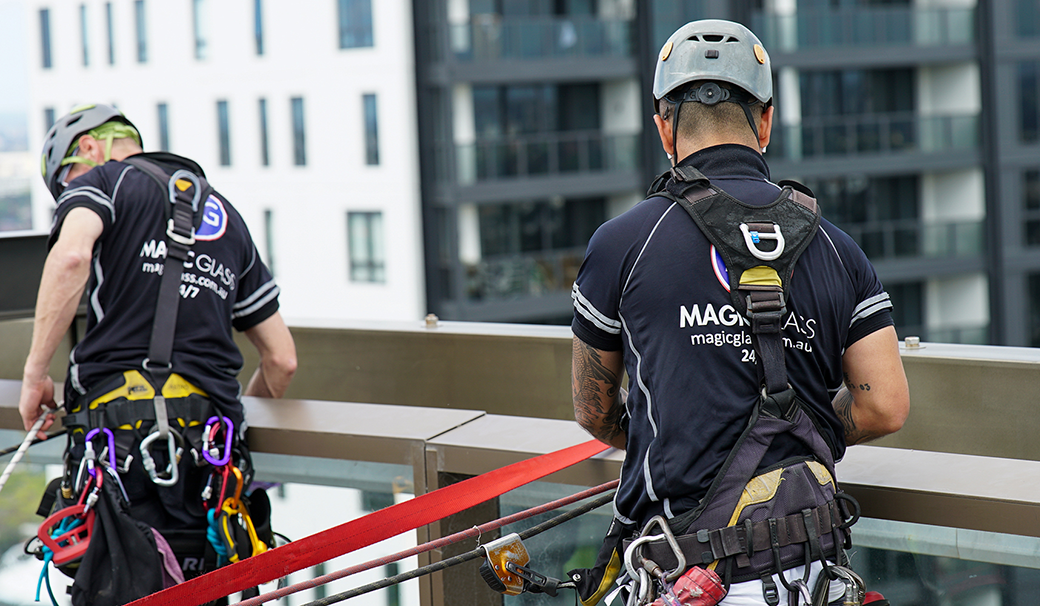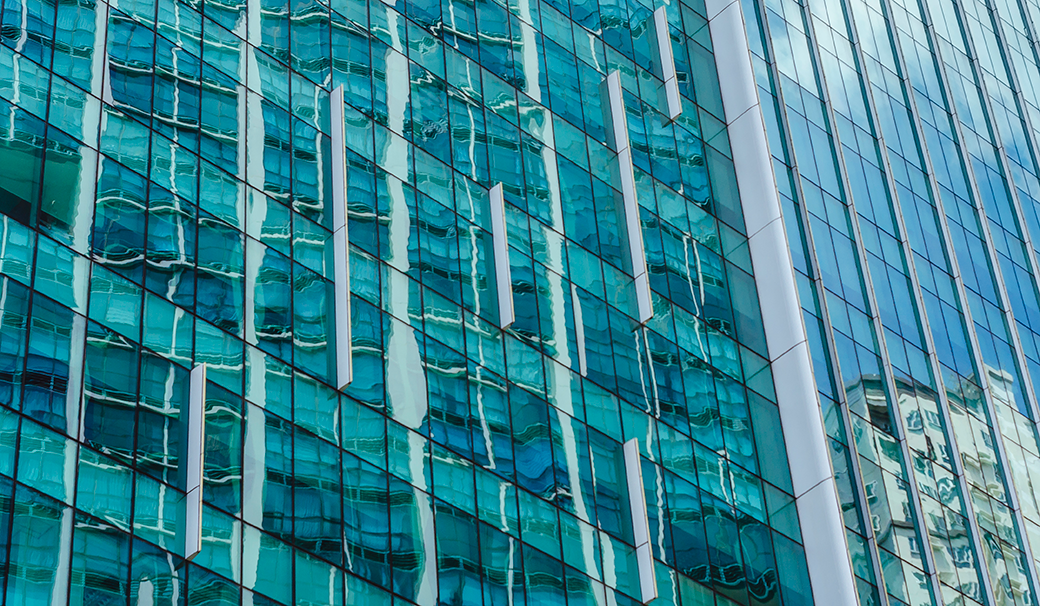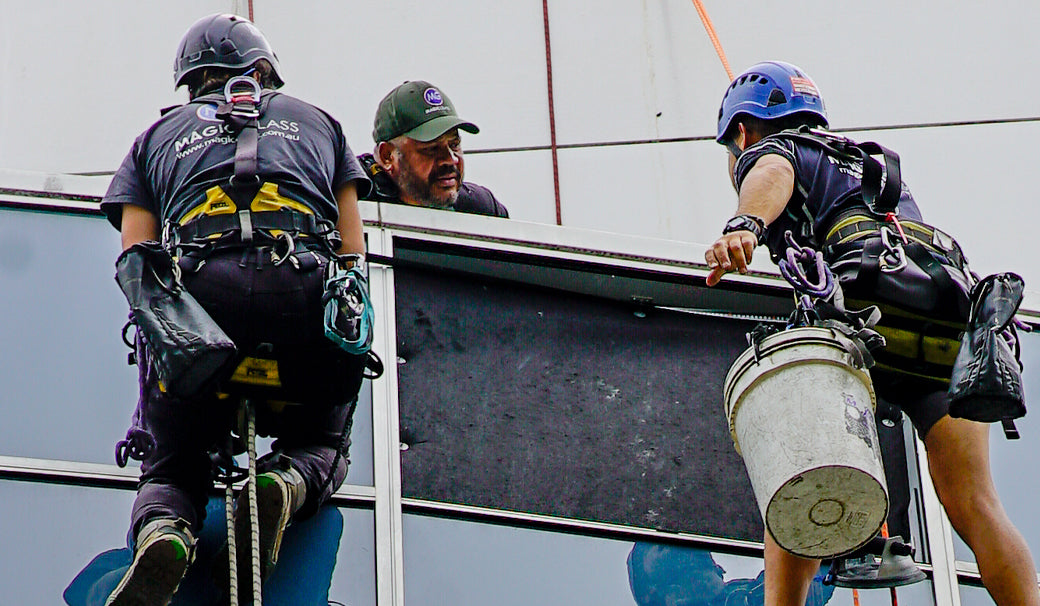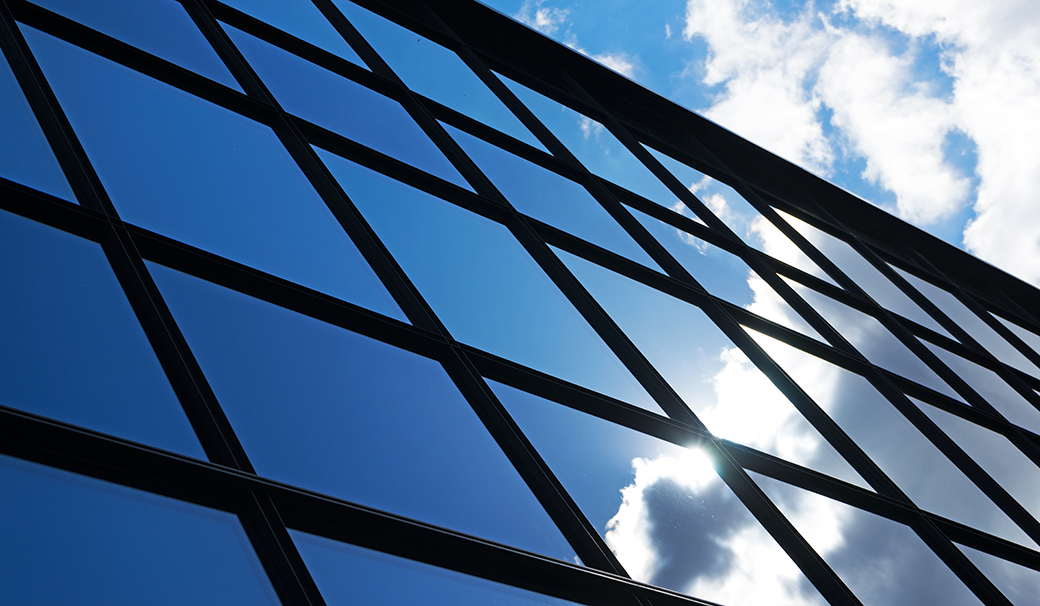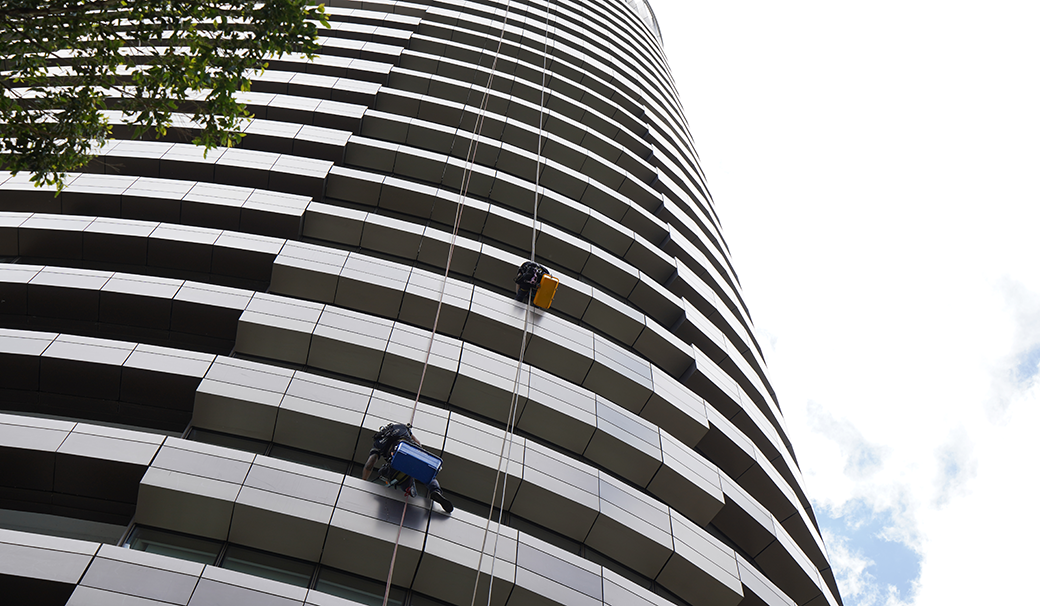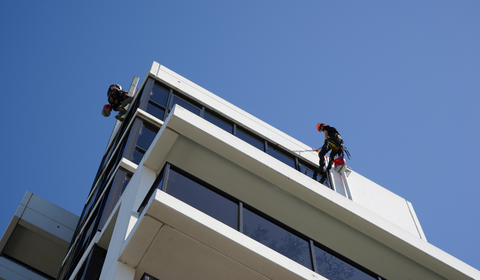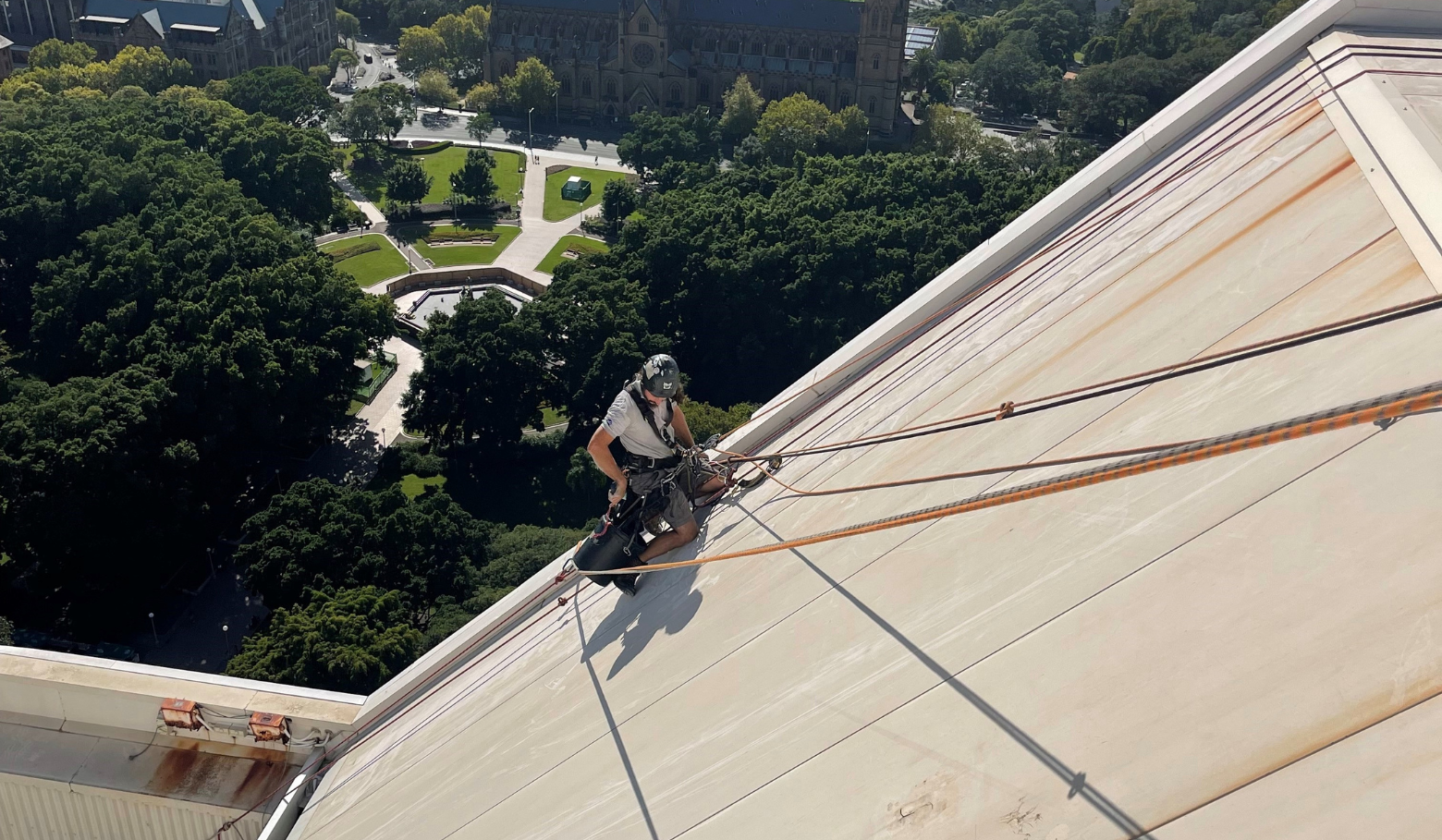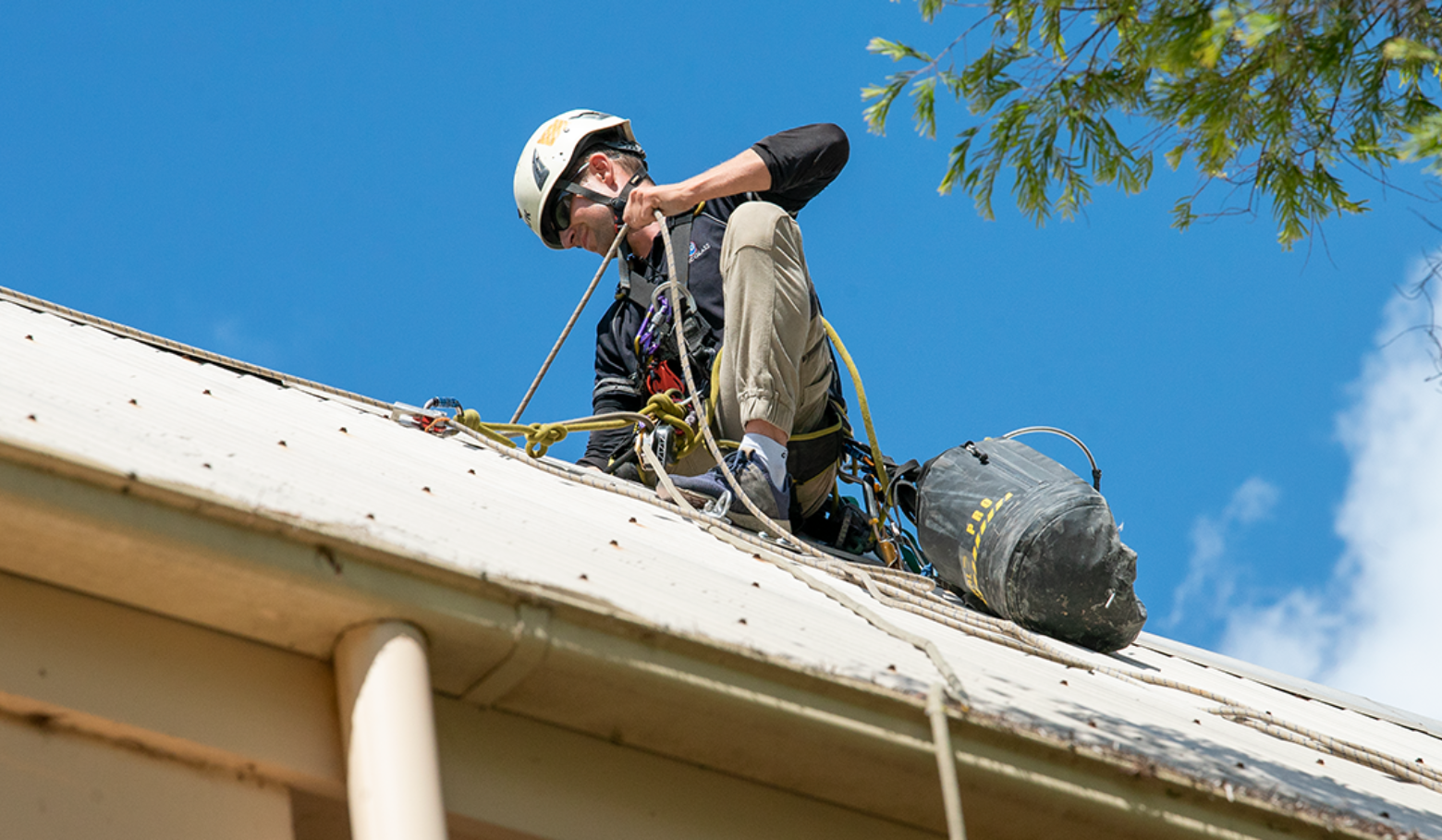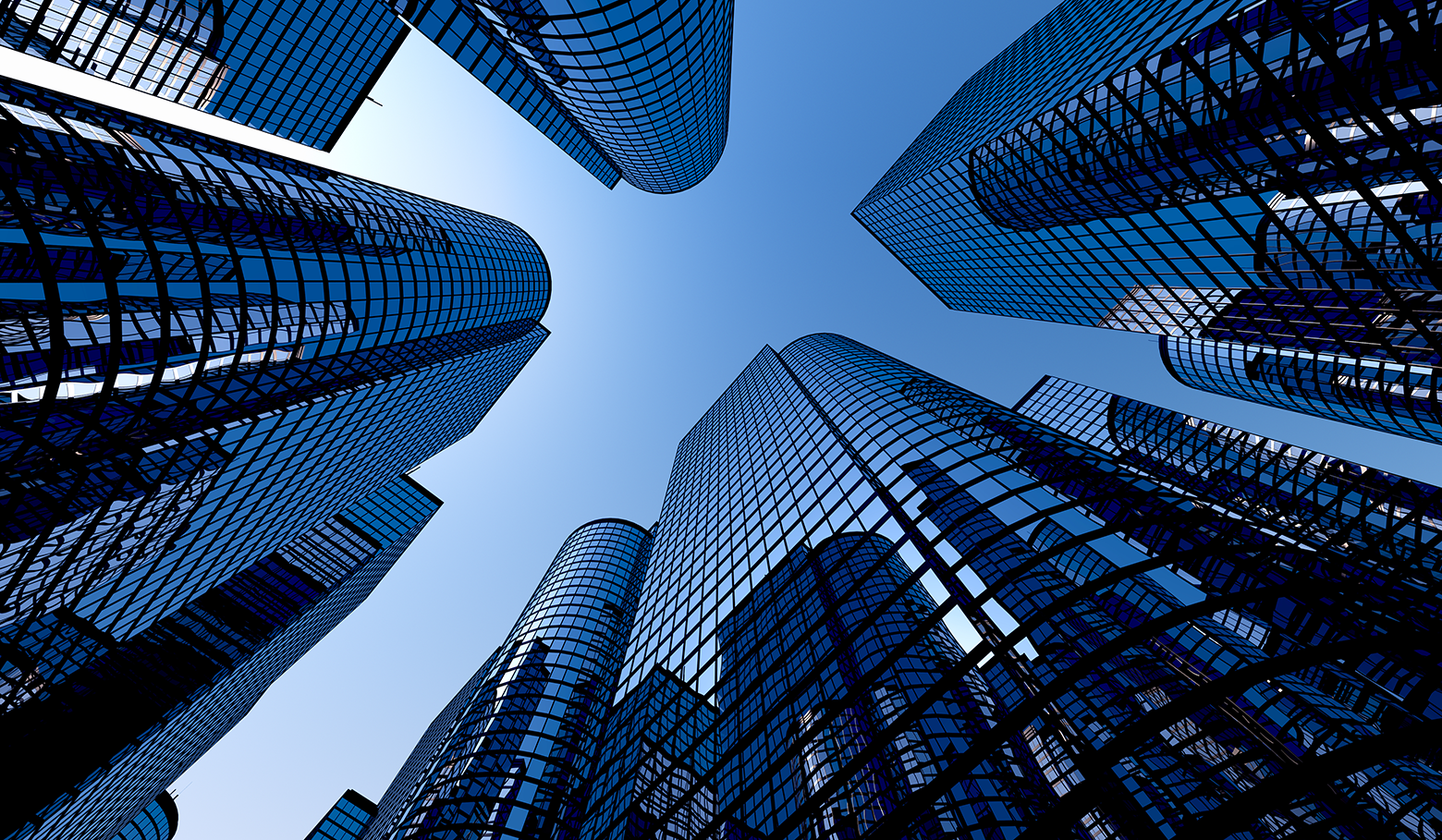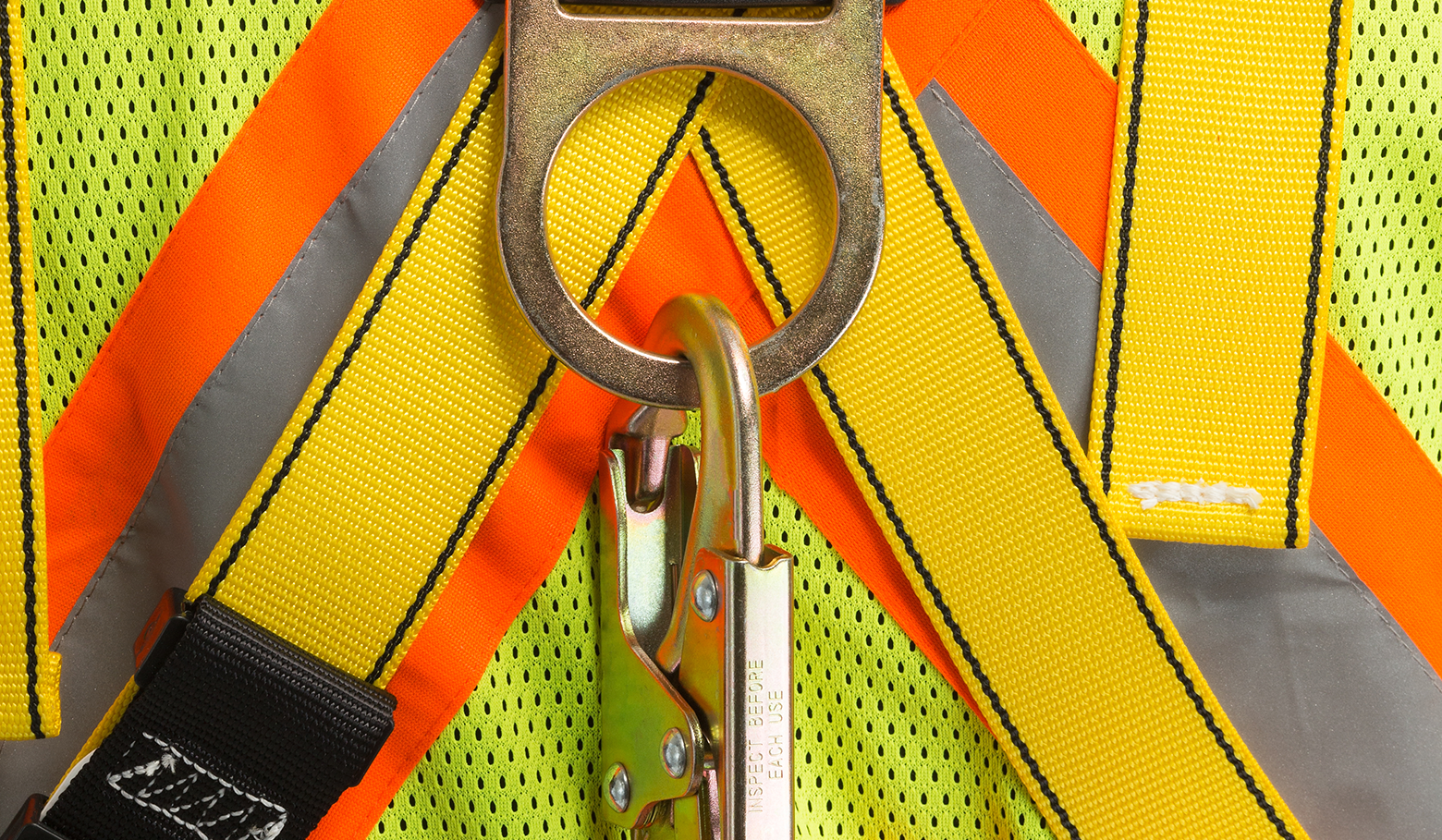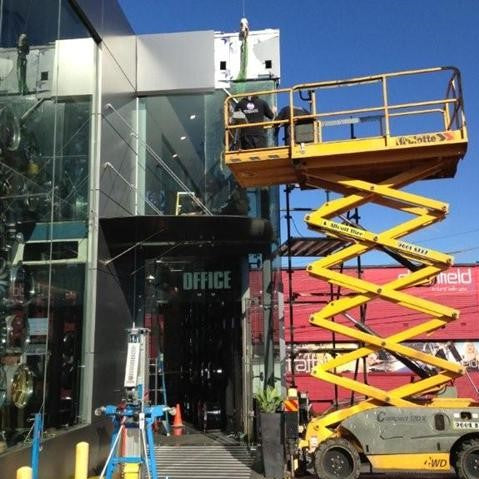Glass Blog
Rope access is a method used to reach high or difficult-to-access areas via a rope and harness system. It is commonly used to conduct a variety of work including glazing, cleaning, installation, restoration, repair, waterproofing, and painting.
What are the Benefits of Rope Access?
Rope access is the access method of choice for many building owners, property managers, strata managers, and facility managers. This is because it presents many benefits over alternative methods of access. Some of these benefits include:
- Efficiency: Rope access equipment can be assembled and disassembled very quickly. This reduces time requirements, allowing for a more efficient service.
- Safety: Rope Access Technicians must undergo extensive training in order to conduct rope access work.
- Versatility: Rope access allows workers to access areas that would not be accessible using other methods. It does not restrict mobility and can be used in an abundance of areas ranging from confined spaces to large-scale high-rise buildings.
- Environmentally Friendly: As rope access does not require the transportation of large, heavy equipment through the supply chain and on-site, it releases much fewer emissions than alternative access methods.
- Minimises Disruption: Compared to alternative height access methods, such as scaffolding, rope access has minimal disruption on a building and the building’s occupants.
If you require any work for your high-rise building or other hard-to-access structure, get in touch with Magic Glass. Our certified Rope Access Division offers a variety of services for both commercial and residential clients. These services include:
- External window and facade cleaning
- Height safety installation
- Make safe services
- Facade inspection and reporting
- Facade remedial repair
- Safety and debris netting
- Bird proofing and pest control
- Rust removal
- Facade painting and waterproofing
- Signage installation and removal
And more!
Contact Magic Glass for more information.
Cladding systems are external wall systems that can be applied to the outside of buildings. They are used on both residential and commercial buildings, and offer numerous benefits including additional structural protection, noise and heat insulation, and improved aesthetics.
There are several different types of cladding, all of which have various pros and cons. Read on to find out about 6 of the most common types of cladding.
Vinyl Cladding
Due to its high durability, visual appeal, and low-cost, vinyl cladding is very popular in and around Sydney.
Made of a mix of PVC and other materials, vinyl cladding typically comes in the form of horizontally-placed panels. These panels can also be fitted with additional layers of insulation, allowing for greater thermal control within the building.
Compared to alternative cladding options, vinyl is considerably more lightweight, allowing panels to be completely flexible when covering a building. They are also available in countless colours, allowing for greater design versatility.
Timber Cladding
Timber is another popular material choice for cladding. It allows for an aesthetically pleasing finish as well as improved thermal insulation. Timber cladding is also eco-friendly and a great way for building owners to reduce their carbon footprint.
Timber cladding can, however, be costly and tricky to maintain. You’ll likely need to re-paint or re-stain your timber cladding every 3-5 years and take extra care to protect it from pests and rotting.
Stone Cladding
Stone cladding is more common for residential buildings rather than commercial buildings. It provides an elegant, luxurious finish for homes and is easy to maintain and highly effective in preventing moisture from getting in.
The main drawback of stone cladding is that it can be extremely expensive. Both material costs and labour/installation costs are very high.
Metal Cladding
Metal cladding, particularly aluminium cladding, is another very popular choice in Sydney. It provides a shiny and contemporary look for both residential and commercial buildings.
Metal cladding is popular because it’s versatile, easy to work with, lightweight, low-maintenance, cost-effective, and energy efficient. It is, however, susceptible to denting and is a poor sound insulator.
Brick Cladding
Brick cladding is another great option for adding a stylish touch to your building’s exterior. It is highly versatile when it comes to design, allowing for colour and textural customisation.
As brick is a very sturdy material, it provides a high level of protection against the elements and is very easy to maintain.
The installation of brick cladding can incur high labour costs, however, so it is one of the more expensive cladding options.
Glass Cladding
Last but not least, we have glass cladding. This type of cladding is most commonly used on commercial buildings to boost aesthetics and provide a modern and unique feel. It is also a great thermal insulator, requires little maintenance, and is capable of withstanding harsh weather conditions.
Glass cladding can, however, be expensive to install and clean, and is unsuitable for earthquake-prone areas.
For all your cladding installation, replacement, and maintenance needs, get in touch with Magic Glass. Our dedicated Rope Access Division can offer cost-effective and discrete cladding services for all buildings of all heights.
- Architectural Glass Solutions
- Building Maintenance
- Commercial Glass Installation
- Commercial Glass Replacement
- Commercial Glass Services
- Commercial Glazing
- Custom Glass
- Facade Services
- Glass Installation
- Glass Projects
- Glass Solutions
- Hi-Rise Glass
- High Rise Glass Services
- Rope Access
- Sydney Glass Company
If you own or manage a high-rise building, it’s your responsibility to ensure that it is safe for all residents, visitors, workers, and passer-byers. If your building is deemed unsafe and injury occurs, you can be held liable.
One of the best ways to avoid this is to familiarise yourself with common defects that can occur and how to best deal with them. Read our blog on common building defects for more information on how to identify them. Otherwise, read on to find out how to best deal with high-rise defects.
Handling Building Defects
Different buildings will encounter different defects. The process of dealing with these defects can be generalised, however. Here are some top tips:
Remember that ignorance is not always bliss.
As we’ve previously stressed, if you own or manage a building, any defects that occur are your responsibility. Because of this, you want to be aware of how to identify any potential issues and have a basic idea of how to remedy them.
Be safe, not sorry.
Thorough and regular building inspections by accredited professionals, such as Magic Glass, are a must! They will identify any potential issues before you notice them. Not only will this ensure safety in your building, but it will also save you money as repairing damage in its early stages is much less expensive than repairing it a few months in.
In NSW, for minor defects, you have two years to start the process of getting the builder or developer to fix the defect. For major defects, you have six years. If your building is outside the warranty period, you may have to fund rectification yourself.
Sharing is caring.
Make sure you report defects to people who need to know. This will include your owners corporation, but also your insurer(s) and Fair Trading (especially if the defect is major). You will also need to inform residents and other building occupants if necessary.
Keeping good records is also important. Records are needed in case there are disputes and to demonstrate to future buyers that the building is well-maintained and safe.
Handling building defects can be stressful. Fortunately, Magic Glass is here to help. We offer fast, thorough, and cost-effective facade inspection, repair, and replacement services. Our experienced Rope Access Division allows us to carry out these services discreetly for all buildings, regardless of height or size.
Contact us today for more information!
If you own or manage a high-rise building, it is your responsibility to make sure it is inspected thoroughly and regularly. This will ensure your building is safe for all inhabitants and passer-byers, and prevent the need for expensive restoration and repair work as a result of unnoticed and untreated structural maladies.
Failure to get your high-rise building inspected regularly can result in severe structural complications that can inflict injury, cause mortalities, and leave Building Managers and Owners liable for negligence.
Read on to learn more about what building inspections are and why they are important.
What are High-Rise Building Inspections?
A building inspection is a routine inspection of the property. It is carried out by an accredited professional to identify any existing or potential issues with the structural stability of the building. Most inspections will include an assessment of the building’s foundation and roofing, exterior walls and facade, and height safety installations.
Why Do High-Rise Buildings Need Regular Inspections?
High-rise buildings are particularly susceptible to safety breaches. Ensuring your building is inspected regularly will therefore give you the best chance of making sure your building is in compliance with all relevant safety regulations. It will also prevent the occurrence of catastrophic building defects that can be hazardous to residents, workers, and the general public alike.
In addition, regular high-rise inspections can help identify and treat any minor issues before they become serious. This can prevent any major disruptions and expenses associated with major structural repairs and restorations, and increase the value of your property.
How Often Should High-Rise Buildings Be Inspected?
How often your building should be inspected is dependent upon a number of factors such as its age and environment.
In order to get an accurate idea of how often you should be having your building inspected, we recommended you get in touch with the Magic Glass team. We’ll be able to advise you on when you should get your building inspected, as well as provide you with a free quote.
Our Magic Glass Rope Access Division can carry-out thorough external building inspections quickly and with minimal-disruption. We can also perform high-rise window and facade cleaning, height safety installations, remedial repair works, and facade painting and waterproofing services.
Contact us today for more information.
Rope access is a relatively new form of access method that more and more businesses are beginning to employ. Because it’s so new and often perceived as ‘scary’, many people have questions surrounding rope access and its uses.
Fortunately, Magic Glass is here to answer some frequently asked questions about rope access.
What is Rope Access?
Rope access is a form of work positioning that allows workers to access difficult - to - reach areas without the need of scaffolding or aerial work platforms . It involves the use of ropes and harnesses to support the worker as they complete the required job.
Why Use Rope Access?
There are a multitude of reasons why rope access is becoming more commonly used. These include:
- Increased safety
- Increased versatility
- Less disruption to the building
- Increased efficiency
- More cost - effective
What are the Applications of Rope Access?
Rope access is most commonly used in the construction industry. It can be used for:
- Structural inspections of buildings
- Height safety insta llations
- High - rise window and facade cleaning
- Concrete repair
- Painting and waterproofing
- Glass repair and replacement
- Signage installation and removal
Can Anyone Become a Rope Access Technician?
In order to become a Rope Access Technician you must undergo mandatory IRATA training to become certified.
Magic Glass Rope Access Division
Our Rope Access Division can offer a number of services such as:
- External window and facade cleaning
- Height safety installation
- Make safe services
- Facade inspection and reporting
- Facade remedial repair
- Safety and debris netting
- Bird proofing and pest control
- Rust removal
- Facade painting and waterproofing
- Signage installation and removal
And more!
To get a free quote on your rope access job, contact Magic Glass today.
If you’re a property owner or strata manager, it is your responsibility to ensure your building is kept in good condition. This not only ensures that your building is looking good, but also ensures that it is safe for its occupants and the general public, alike.
An important step in doing this is getting regular facade inspections.
Regular facade inspections are critical in maintaining the safety and visual appeal of buildings. They can identify potential issues before they become major structural complications, in turn, saving you money and drastically reducing the risk of injury and mortality. Regular inspections can also improve the aesthetics and value of your property.
Facade inspections regularly pick up issues that cannot be seen from the ground and could be potentially dangerous if not fixed, such as cracked render and concrete.
It is generally recommended that building owners and managers get their property’s facade inspected every 5 years if their building is in excellent condition. If it is in fair condition, it should be inspected every 2-3 years, and if it is in poor condition, it should be inspected yearly.
If you notice any physical signs of deterioration, such as cracks, rust stains, deterioration around balconies, and displacement of stone, concrete blocks or bricks, you should get your building inspected immediately.
For facade inspections of both commercial and residential buildings, contact the Magic Glass team. Our experienced Rope Access Technicians can conduct thorough and efficient external property inspections for high-rise buildings of all sizes.
Call us today for a free quote.
When it comes to working at heights, implementing effective safety procedures is a must. Falls from heights are the second leading cause of work-related mortalities within Australia, so ensuring your building or worksite is secure and has preventative measures in place is critical.
The most common types of height safety systems are fall arrest and fall restraint systems. Although they are commonly used interchangeably, they have a number of key differences. Read on to find out more.
Fall Arrest Systems
Fall arrest systems are designed to protect workers in the event of a fall. When a worker falls, the arrest system will catch them, preventing the occurrence of injuries or deaths.
Fall arrest systems fall into two categories - personal and general. Personal fall arrest systems involve specific Height Safety PPE and attachment systems, such as harnesses and ropes. General fall arrest systems protect all workers as a whole rather than individually, such as safety nets and catch platforms. Both types of fall arrest systems should prevent workers from falling no more than two metres.
Examples of fall arrest systems include:
- Full-body harnesses
- Suspension belts
- Rope lanyards
- Safety nets
- Catch platforms
Fall Restraint Systems
Fall restraint systems are preventative safety measures. They are designed to prevent falls altogether, rather than catching workers after they have fallen.
Examples of fall restraint systems include:
- Guardrails
- Walkway systems
- Static restraint lines
These restraint systems are used for lower-risk situations, where falling is less likely or less hazardous.
Having effective fall protection systems in place is an absolute necessity in preventing workplace injuries and deaths.
If you’re unsure about your requirements or what fall protection equipment you should be using for your building or worksite, get in contact with Magic Glass for more information.
Proper maintenance of your building’s exterior is critical not only in terms of visual appeal, but also in terms of safety and functionality. Conducting facade inspections, cleaning and repairs can be a complex and time-consuming process, however. Fortunately, the use of rope access can make facade maintenance much more simple.
What is Rope Access?
Rope access involves the use of ropes and harnesses to traverse the exterior of buildings to conduct inspections, repairs, removals, installations, and cleaning services.
Due to strict training requirements and safety standards, rope access is considerably safer than alternative access methods such as the use of scaffolding and cranes.
Why is Rope Access Ideal for Facade Maintenance?
Aside from being the safest access method, rope access is also a faster, less-disruptive, and less-expensive method of carrying out facade maintenance work.
With little set-up and pack-up times, rope access drastically reduces the time it takes to carry-out facade work. This, in turn, cuts costs associated with labour and equipment and makes the process much more straight-forward.
In addition, the lack of scaffolds, platforms and cranes makes rope access a much more subtle process. This reduces disruption to your building and its inhabitants and won’t compromise your building’s visual appeal.
Rope access is also much more ideal for facade maintenance as it provides workers with greater mobility and flexibility to move around the building. This allows them to reach more difficult-to-access areas with very little restriction from equipment.
If you’re wanting to make the change to rope access, get in contact with the Magic Glass team today. Our dedicated Rope Access Division offers an abundance of services that will keep your building’s facade clean, safe and functional.
- Anchor Point Installation
- Building Maintenance
- Commercial Glass Replacement
- Commercial Glass Services
- Commercial Glazier
- Commercial Glazing
- Facade Cleaning
- Facade Maintenance
- Facade Services
- Glass Maintenance
- Glass Services
- Glazing Services
- Hi-Rise Glass
- High Rise Glass Services
- Magic Glass
- Rope Access
- Window Cleaning
When it comes to Rope Access, an acronym that is frequently thrown around is IRATA. If you’ve heard this acronym but are unsure as to what exactly it means, this article is for you.
What is IRATA?
IRATA stands for the Industrial Rope Access Trade Association. This association was established in the United Kingdom in the 1980s as a means for providing a safe working environment in the oil and gas industry.
As these industries began to employ a number of industrial rope access techniques, it was recognised that ensuring these practices were safe was an important factor in maximising workplace health and safety. From this, IRATA developed their own rope access technique that emphasised safety and could be used in a range of repair, maintenance, inspection, and access work.
IRATA is now recognised as the world’s leading authority on industrial rope access. It has over 570 member companies globally and has trained roughly 130,000 Rope Access Technicians from a multitude of different countries.
IRATA directs and regulates the training of all Rope Access Technicians seeking IRATA qualifications and certifications.
What Does IRATA Do?
IRATA’s main activities include:
- Regulating the IRATA system as used by their members.
- Reviewing and updating policies and procedures relating to standards, audit, and assessment.
- Promoting and maintaining a high standard of industrial rope access activities in terms of safety and quality.
- Providing guidance and training of personnel involved in industrial rope access.
- Producing publications and guidance on safety, good working practices, training, and other related topics.
- Preparing submissions and providing opinions and advice to global government departments and organisations surrounding work at-heights, health and safety, and training.
- Ensuring safe rope access training and work procedures are introduced and developed.
- Supporting members with enquiries.
- Organising annual events for the rope access community.
What are the Objectives of IRATA?
The main aims of IRATA are as follows:
- To promote and maintain high standards in safety and work quality of practices in the industrial rope access industry.
- To improve the practices of individuals working in rope access.
- To promote continuous improvement in the education and training aspects of rope access.
- To increase awareness surrounding the advantages of rope access over alternative access methods.
IRATA plays a paramount role in promoting and encouraging safe rope access practices around the world. They offer thorough training and certification programs for Rope Access Technicians to ensure they maintain a high standard of safety and quality when carrying out work at-heights.
At Magic Glass, all our Rope Access Technicians are IRATA trained and certified. This ensures all our practices are of the highest safety standards, and all our work is of the best possible quality.
For any repair, maintenance, and installation requirements at-heights or in hard-to-access areas, get in contact with the Magic Glass Rope Access Division now!
Although rope access may appear scary to many, it is actually the safest option when it comes to height access work.
Compared to alternative methods such as scaffolding and cranes, rope access has very little risk. This is due to several factors outlined below.
1. Full Accreditation Required
In order to become a Rope Access Technician in Australia, you must be fully accredited and IRATA trained.
All Rope Access Technicians at Magic Glass undergo thorough training before they are permitted to work. This enables them to become familiar with all safety procedures and protocols and understand how to tackle all jobs at-height as safely as possible.
2. Less Equipment, Less Risk
Compared to using scaffolding or cranes, rope access requires very little equipment and set-up.
Because of this, there is less space where something could go wrong and less equipment that could fail.
3. Less Time, Less Risk
Rope access is also by far the fastest and most efficient method of height access work.
Because of this, there is less time for complications to arise or for something to go wrong.
4. Safer for Passer-Byers
Rope access is also much safer for passer-byers of the building or construction site.
This is because all tools required for the job at hand are secured to Technicians via ropes and harnesses. In the event that a Technician accidentally drops their tool, it will stay intact to the Technician instead of falling to the ground and potentially harming pedestrians and other workers on the way.
For all your rope access needs, get in contact with the Magic Glass team.
All of our dedicated Rope Access Technicians are highly experienced and IRATA trained.
Fall arrest systems are an important part of all at-height construction and work sites. They play a critical role in reducing workplace injuries and fatalities caused by falls. To learn more about fall arrest systems and the different types, read on.
What are Fall Arrest Systems?
A fall arrest system protects workers in the event of a fall. If a person working near an unprotected edge should take a fall, the fall arrest system combined with a fall arrest harness will catch the person and prevent them from hitting the ground or area below.
It’s important to note that fall arrest systems are different to fall prevention systems. Fall arrest systems protect workers after they’ve fallen, whilst fall prevention systems prevent the occurrence of falls (such as edge protection and roof guardrails).
What are the Different Types of Fall Arrest Systems?
Fall arrest systems can be categorised as either general or personal. General fall arrest systems include nets and catch platforms, whilst personal arrest systems include lanyards and harnesses.
Some of the most common types of fall arrest systems include:
- Static Lines
- Anchor points
- Rope grabs
- Safety nets (ideal for worksites where there are no scaffolds, and the fall hazard is less than 25 metres)
- Rails
Many of these fall arrest systems involve anchor points. These are points where workers can attach their lanyards to anchor themselves to the building and catch them in the event of a fall.
Like all fall arrest equipment, it is important to get anchor points inspected regularly and ensure they are certified for use. All height Safety systems must be inspected and certified every 12 months by a certified professional.
When Should Fall Arrest Systems be Used?
Fall arrest systems should always be used when working at a height that could potentially cause injury in the event of a fall. This may include when carrying out electrical, glazing, cleaning, and roofing work.
Even if the risk of injury is minimal, at least one form of fall protection should always be used.
If you require height safety installation, get in contact with the Magic Glass team. We are highly experienced in installing, inspecting, and certifying a range of different height safety hardware including fall arrest systems, anchor points, safety ladders, ladder points, and temporary and permanent edge protection.



